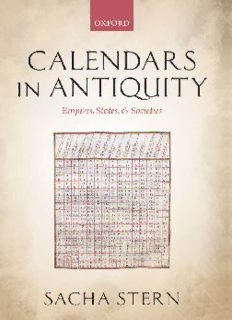
Calendars in Antiquity: Empires, States, and Societies PDF
Preview Calendars in Antiquity: Empires, States, and Societies
CALENDARS IN ANTIQUITY This page intentionally left blank Calendars in Antiquity Empires, States, and Societies SACHA STERN 1 3 GreatClarendonStreet,OxfordOX26DP, UnitedKingdom OxfordUniversityPressisadepartmentoftheUniversityofOxford. ItfurtherstheUniversity’sobjectiveofexcellenceinresearch,scholarship, andeducationbypublishingworldwide.Oxfordisaregisteredtrademarkof OxfordUniversityPressintheUKandincertainothercountries #SachaStern2012 Themoralrightsoftheauthorhavebeenasserted FirstEditionpublished2012 Impression:1 Allrightsreserved.Nopartofthispublicationmaybereproduced,storedin aretrievalsystem,ortransmitted,inanyformorbyanymeans,withoutthe priorpermissioninwritingofOxfordUniversityPress,orasexpresslypermitted bylaw,bylicenceorundertermsagreedwiththeappropriatereprographics rightsorganization.Enquiriesconcerningreproductionoutsidethescopeofthe aboveshouldbesenttotheRightsDepartment,OxfordUniversityPress,atthe addressabove Youmustnotcirculatethisworkinanyotherform andyoumustimposethissameconditiononanyacquirer BritishLibraryCataloguinginPublicationData Dataavailable LibraryofCongressCataloginginPublicationData Dataavailable ISBN 978–0–19–958944–9 PrintedinGreatBritain onacid-freepaperby MPGBooksGroup,BodminandKing’sLynn LinkstothirdpartywebsitesareprovidedbyOxfordingoodfaithand forinformationonly.Oxforddisclaimsanyresponsibilityforthematerials containedinanythirdpartywebsitereferencedinthiswork. Preface This book is intended not as a catalogue, but as a piece of social history. Calendarsarenotatechnicalcuriosity,butafundamentalaspectofsociallife, an organizing principle of human experience, a constitutive component of cultureandworldviews.Mypurposeinthisbookistoexaminethestructure ofalltheknowncalendarsoftheancientNearEastandMediterranean,andto capturethesocialcontextoftheirlargelycommonhistory. The chapters in this book follow at once a thematic and an approximate chronologicalorder,exceptforGreece,whichforvariousreasonsIhaveplaced before the much earlier Babylonian and Egyptian calendars (Chapters 1–3). Mycentralargument,intheseandsubsequentchapters,isthatcalendarswere primarily political; their development was closely related to the political changes that transformed the ancient world from the mid-first millennium BCEtolateAntiquity.Theriseoflarge-scaleempiresinthisperiodsuchasthe Achaemenid, Seleucid, and Roman Empires led to the formation of increas- ingly fixed and standardized calendars, most notably the Persian and the Juliancalendars(Chapter4).Thebreak-upoftheSeleucidEmpire,conversely, ledtothefragmentationofcalendarsintheNearEast(Chapter5).InChapter 6,IarguethattheunofficialuseoflunarcalendarsintheRomanEmpire,such as the Gallic and Jewish calendars, was a way of expressing subtle political dissidence. In Chapter 7, I investigate the relationship between the calendar andsectarianism,heresy,andsocialschisminJudaismandChristianityoflate Antiquity. Ihavewrittenthisbookwiththegeneralreaderinmind,avoidingasfaras possibleexcessivetechnicaldetail.Noteveryonewillbefamiliarwithallthese areas and periods of history. Some readers may restrict themselves to their ownareasofinterestorspecialization;buttheConclusion,whichsumsupthe argumentofthewholebook,ismeantforalltoread. Ifirstconceivedthisbookin2003,duringaperiodofresearchleavefunded by the Arts and Humanities Research Board (now AHRC); but because of professional distractions, it has taken many years to complete. I wish to acknowledge the personal assistance that many friends and colleagues have given me in areas that often lay beyond my expertise. The following read earlier versions of chapters or parts of chapters, and contributed insightful, informative, and critical remarks: Robert Parker (Ch. 1), Samuel Greengus, JohnSteele (Ch.2), Leo Depuydt (Ch.3), François de Blois(Ch.4. 1), David Levene(Ch.4.3),ChrisBennett(Ch.5andpartsofCh.1),JonathanBen-Dov and Fergus Millar (parts of Ch. 7); and last but not least Jörg Rüpke and vi Preface Leofranc Holford-Strevens, who read and commented on the entire manu- script.AnearlydraftofChapter5wassenttoPeterDerow,myformertutor, daysbeforehisunexpecteddemise;thelateSimonPrice,anotherformertutor, readandcommentedonpartsofthesamechapter;Idedicateittoboththeir memory. The book as a whole, however, is dedicated to my wife Evadne, whose share in this work has been earned through tireless support and steadfastfriendship. A generous reviewer (J. M. Baumgarten 2003, himself the author of lucid studies on the Qumran calendars, who died as I was completing the last chapterofthispresentwork)describedmypreviousworkonJewishcalendars as‘achallengingandexcitingforayintothelinksbetweenthemeasurementof timeandamillenniumofJewishsocialhistory’.Ihopethesamewillbesaidof this present work: through the study of ancient calendars, a new perspective onAntiquitywillhavebeenachieved. SS London,September2011 Contents ListofTables ix Introduction 1 PART I. FROM CITY STATES TO GREAT EMPIRES: THE RISE OF THE FIXED CALENDARS 1. CalendarsofAncientGreece 25 2. TheBabylonianCalendar 71 3. TheEgyptianCalendar 125 4. TheRiseoftheFixedCalendars:Persian,Ptolemaic, andJulianCalendars 167 PART II. THE EMPIRES CHALLENGED AND DISSOLVED: CALENDAR DIVERSITY AND FRAGMENTATION 5. Fragmentation:BabylonianandJulianCalendarsintheNearEast, ThirdCenturyBCE–SeventhCenturyCE 231 6. DissidenceandSubversion:Gallic,Jewish,andOtherLunar CalendarsintheRomanEmpire 299 7. SectarianismandHeresy:FromQumranCalendarsto ChristianEasterControversies 355 Conclusion 425 Bibliography 431 Index 455 This page intentionally left blank List of Tables 1.1 OrdinaryandintercalatedyearsatAthens,late secondcenturyBCE–secondcenturyCE 40 1.2 OrdinaryandintercalatedyearsatAthens,thirdcenturyBCE 43 2.1 Intercalationsintheneo-Babylonianperiod 101 2.2 IntercalationsunderCyrus,Cambyses,and(early)DariusI 103 2.3 TheSarosCanonandtheoptimal19-yearcycles 106 2.4 IntercalationsunderDariusI,Xerxes,andArtaxerxesI 108–9 2.5 IntercalationsinthelaterAchaemenidandSeleucidperiods 112–13 2.6 BabylonianintercalationsintheParthianperiod 116 2.7 IntercalationschemesintheBabyloniancalendar 119 4.1 RepublicanandJulianmonthlengths 213 5.1 DoubledatesinPtolemy’sAlmagest 239 5.2 Seleucidmonths 240 5.3 TheSyrian-Antiochenecalendar 257 5.4 TheEgyptiancalendarintheAugustanperiod 266–7 5.5 ThecalendarmonthsofSalamis 272 5.6 ThecalendarofAsiaanditsvariantsaccordingtothehemerologia 280–1 5.7 ThecalendarofHeliopolisinthehemerologia 286
Description: